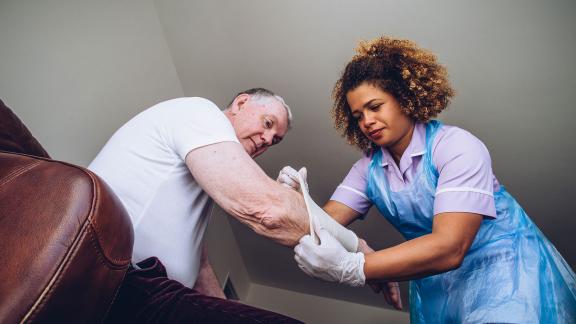Community health services can only absorb so much pressure

Community health services have played a key role throughout the pandemic, but as the second wave bites they face competing pressures, writes Andrew Ridley, chair of the Community Network.
Community service providers are now contending with workforce pressures, a growing demand for services and a swelling backlog of care alongside the need to maintain non-COVID and COVID-related services like surge beds, care home in-reach teams and rapid response. Many of them will also lead aspects of the COVID-19 vaccination programme.
Rising to the challenge
In the first wave, community providers rose to the challenge to provide essential COVID and non-COVID care, while maintaining patient flow to support the wider health system.
They did so despite pre-pandemic pressures including rising demand, workforce shortages and funding squeezes.
Following national guidance, they were able to prioritise some services and reshape others, including moving consultations online where appropriate. They implemented a new discharge policy to get medically fit people home as quickly and as safely as possible, freeing up hospital beds in the process.
Within a few months of stepping down and scaling back non-essential services, providers began the much harder task of reinstating them, while balancing the extra responsibilities of COVID-19 services and managing more complex demand in the community.
This left many providers and their staff feeling the strain. Yet several community providers told us they systematically restored all their services to near-normal levels over this period, with one large trust recently noting that, aside from a few walk-in clinics, most of their other services were running at normal or above normal levels.
Community health services providers have also worked to embed successful new ways of working, such as remote monitoring and virtual consultations, to free up the capacity needed to meet high levels of demand.
While these innovations have helped to free up some capacity, efficiency gains are generally offset by the additional resource required to implement rigorous and essential infection prevention and control measures.
Rising again
In this second wave, community providers are now managing these COVID and non-COVID pressures at the same time as responding to the usual increase in seasonal illnesses as we move into winter, as well as continuing to provide essential support to care homes, the clinically vulnerable and those waiting for elective care.
The increase in the number of COVID-19 patients in hospital beds means that, in the coming months, there will also be knock-on increases in demand for community health services when these patients are discharged.
All of these pressures will be compounded by the demand for new long-covid services. The £10 million funding announced for ‘long covid’ clinics in October 2020 will help with the initial diagnostic screening of these patients, but it will not cover the ongoing treatment packages required. Community services urgently need additional investment across the community health and community mental health pathway to fund these COVID-induced ongoing care needs.
Tied to concerns about the provision of ongoing care, trusts are also reporting an increase in delayed discharges from acute settings. While there are complex reasons behind this, the resulting longer stays in hospital are likely to lead to deconditioning for many patients. In turn, this will create further demand pressures on community services who will then need to provide rehabilitation and reablement services for discharged patients.
On top of all this sits the leading role that community providers will take in the roll out of the COVID-19 vaccine over the next few weeks and months.
Faced with these mounting demands, workforce pressures are a significant concern. Some community providers note that staff morale was very low going into the winter, with deep and growing concerns from the community workforce about some of the COVID-19 risks associated with working in people’s homes. With an exhausted and worried workforce, high baseline vacancy rates and risking sickness absence rates, community providers have substantial concerns about how they will cope over the next few months.
The need for support
Providers facing these difficult challenges tell us they need support nationally and to be empowered to make the right decisions for their communities. As part of this, there needs to be investment in the community sector, a commitment to recurrent funding for discharge to assess, and a structural and cultural shift to a ‘home first’ model.
Not only do community services need recognition for their contribution, but they also need immediate support for their staff and the resources to provide the additional delivery that will be required. In the longer term, and especially when we consider the health inequalities highlighted by the pandemic, the government must address the historic under-investment in local authority funding which has led to cuts in public health and social care.
Andrew Ridley is chair of the Community Network, the national voice of NHS community providers, which is hosted by the NHS Confederation and NHS Providers. Follow him on Twitter @CLCHAndrew
This blog first appeared in the HSJ.



